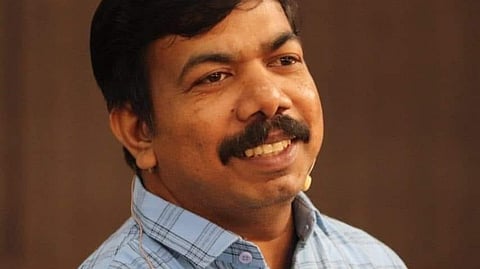

Have you ever wondered what happened to the tree you once circled around as a child in the park? Do you think about the birds that carefully chose sturdy twigs, shaping them into a strong nest? Do you ever stop to anticipate where the cow wandering across a city road came from?
We often notice these small details in our surroundings, but rarely do we seek answers to the questions. What if we started to ask, or rather were guided to pay attention to these changes happening around us, slowly, through the years? How will the conversations around these — a new reality with fewer trees and birds, cattle on the streets — pan out when talking to a parent, teacher, an elder in the locality, a councillor or a Panchayat head?
Encouraging teenagers to think about this environmental reality and “to ask the right questions at the right places” is writer Vishnupuram Saravanan’s 2019 book, Ottrai Siragu Oviya. On June 18, the book found a mention in the list released by the Sahitya Akademi that announced the names of 24 writers for the ‘Bal Sahitya Puraskar’ awards.
According to the writer, this recognition is a bridge for the book to be “known to an unknown audience.” He says, “Whenever a book is released, it is read by a particular circle of audience. To gather newer audiences, the media helps by talking about the book repeatedly. Ultimately, it gets noticed by institutions like the Sahitya Akademi, which recognises and awards a book, taking it to an expanded circle of audiences.”
Not in a fantasy world
The book’s idea is rooted in 2019. Saravanan aimed to explore a narrative about the environmental changes happening around us through a girl who embarks on an adventure, flying through the sky. “If you notice, the number of trees in our villages and cities has significantly decreased. Once, spotting earthworms in the soil was common, but that’s no longer the case. We need to start asking questions about the environment around us, both in the villages we come from and the cities we live in,” explains the author, adding, “I wanted to bring these two ideas together, so that the story of the flying girl isn’t just a fantasy, but a way to learn about and reflect on our environment.”
Every detail mentioned in the book was researched thoroughly. Saravanan took more than a year to collect data on the environmental changes, and penned the book in a month. “Be it earthworms or trees, I did not want to mention them as a matter of fact, but read about it and gave data that could back the reality of how and why the numbers have reduced,” he says.
These data-driven descriptions are crucial because, today, all information can be cross-checked in half a minute. “When books were written 30 years ago, the readers couldn’t verify the information printed. The purpose of writing a book was to inform the public about local and global affairs. Now that there is an abundance of data available, authors need not write stories to share information. This gives writers a certain freedom, but also poses a bigger challenge — in the information overload age, what are you going to say that is not false or misleading,” points out Saravanan.
For answers to come from personal experiences or search, Saravanan, in the book, guides readers to ask crucial questions to the elders. Reasoning the statement, the author says, “These conversations are important, because only when the readers get answers, will they know how to protect what we are left with today. The book will help the kids understand their city and village environment.”
Shaping young minds
Strategically, Saravanan’s thought-provoking story was written for children aged between ten and 14. He adds, “The beauty of kids’ novels is that the audience keeps changing every year — planting the messages as seeds, grows with the ever-evolving readers.”
Writing for this age group comes with its own complexities. The author had to keep in mind that the words written are not 13-15 letters long, a fair-skinned student should not be tagged as a class topper or a black-skinned child as someone who fails subjects. “If such attributes are constantly fed, then the kids tend to believe it to be true,” he says.
For Saravanan, a story has to be interesting, liked and easily understandable. The words used should be the ones the kids use every day. “The story has to be sikkal illamal sindhinai seiyura mathiri (easy to think and understand without any confusion),” says the author, adding that “only then will they take away some learning from each book.”
The recognition for Saravanan’s Ottrai Siragu Oviya started coming in a few years ago. It was translated to Malayalam by PV Sukumaran three years ago and to English by five students from Budding Minds International School, Manimangalam, Chennai, a year ago. This year, it is the Sahitya Akademi. “Every writer will always want more people to read their book. That is made true by Sahitya Akademi’s recognition. I am elated,” concludes Saravanan.